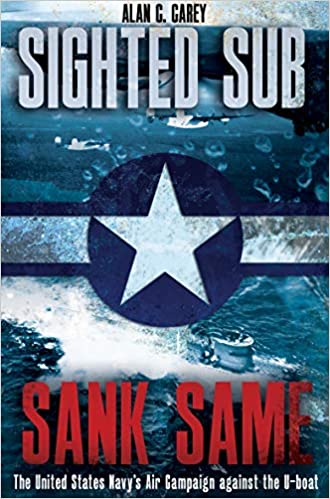
Reviewed by LT Brian Hayes, USNR
This book tells the story of World War II U.S. naval aviation operations against the German U-Boat arm. It’s an interesting and important story, but other books tell it better.
Aircraft were essential to the Allied victory in the Battle of the Atlantic. Unlike modern submarines, early U-Boats operated primarily on the surface, where they were vulnerable to detection and attack from the air. Allied maritime patrol aircraft, equipped with radar and supported by signals intelligence (high-frequency radio direction finding, or HF/DF), could detect and attack surfaced U-Boats. The book’s title echoes the famous radio call claiming – incorrectly, as it turned out – what would have been the first sinking of a U-Boat by a U.S. Navy patrol bomber. Even an unsuccessful attack, however, could force a U-Boat to submerge, thus reducing its effectiveness.
As the war progressed, U.S. naval aviation took the offensive, as “hunter-killer groups” used escort-carrier-based aircraft to search for and destroy U-Boats. Meanwhile, the United States and United Kingdom deployed long-range, land-based bombers to close the gap in Allied air cover that served as the U-Boats’ primary hunting ground. A U.S. inter-service debate over responsibility for anti-submarine patrols resulted in the Navy taking the primary role, even when operating aircraft originally intended for the Army Air Corps.
The author seems to know the subject matter, but the book breaks little new ground. The narrative consists primarily of a series of encounters between aircraft and U-Boats: dates, squadron numbers, aircraft types, and outcomes are included, but there is little accompanying analysis. With the exception of a few interviews and reports of interrogation of German prisoners, the book relies mostly on a handful of secondary sources, such as Carey’s previous books and Samuel Eliot Morison’s official histories. The book also would have benefited from better editing, as it contains a number of distracting misspellings, incorrect uses of commas, and awkward sentence structures.
The book does contain a number of interesting episodes, including the presence of a Japanese submarine (!) in the South Atlantic. Another positive is the decision to include several maps of the area of operations; although these do not pinpoint the specific actions discussed in the text, they provide a useful orientation to the scope of the theater. The book is also interspersed with more than 200 photographs, including a number of combat photographs of U-Boats under attack. Unfortunately, this highlights just how lightweight this book is: despite featuring so many photos, it clocks in at barely 200 pages (including index and appendices).
I recommend this book only to the most obsessive students of the Battle of the Atlantic or of World War II naval aviation. For a better-researched and -written account of the war against the U-Boat – one which includes significant attention to the technical and operational aspects of the air campaign – readers should instead turn to the two volumes of Hitler’s U-Boat War, by Clay Blair.
Alan C. Carey, Sighted Sub, Sank Same: The United States Navy’s Air Campaign against the U-Boat. Casemate Publishing (2019). 240 pp. (with illustrations).
Reviewed by LT Brian Hayes, USNR
Purchase your copy today! amzn.to/3len7Wt

